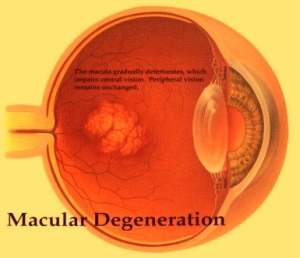 These symptoms can be the early tell-tale signs of the leading cause of serious vision loss and
blindness in the United States – Age-Related Macular Degeneration
(AMD). Particularly affecting the 65 and older age group, it is a
disease that is progressing exponentially. Today, about 1.75 million
Americans have been diagnosed with this disease and the numbers are
expected to grow to about 3 million in 2020.
These symptoms can be the early tell-tale signs of the leading cause of serious vision loss and
blindness in the United States – Age-Related Macular Degeneration
(AMD). Particularly affecting the 65 and older age group, it is a
disease that is progressing exponentially. Today, about 1.75 million
Americans have been diagnosed with this disease and the numbers are
expected to grow to about 3 million in 2020.What is Age-Related Macular Degeneration?
Age-Related Macular Degeneration, or AMD, is a degenerative eye disease that robs a person of their central vision while typically leaving their peripheral vision unaffected. AMD breaks down the macula, the part of the retina responsible for the vision needed for daily tasks such as writing, reading and driving. This disease can affect either one or both eyes. There are two types of AMD:- Dry AMD: When the light-sensitive cells in the macula start to break down, a person will begin to notice a blurred spot in the center of their vision. This is known as dry AMD.
- Wet AMD: In this late-stage type, abnormal blood vessels grow behind the retina. When fluid leaks from these fragile vessels, massive damage is inflicted upon the retina. A person with AMD would see straight lines as wavy. Wet AMD progresses more rapidly than dry AMD, and a person with dry AMD may later develop into wet AMD.
AMD is the leading cause for serious vision loss and blindness in America for people ages 65 years and older/2
How is AMD diagnosed?
AMD is painless and incurable, so early detection is key to catching the disease before extensive damage is done to a person's central vision. Since AMD targets the senior population, eye examinations are especially important to people over the age of 60 so that the disease can be diagnosed in its earliest stages.During a comprehensive eye examination, eye drops would be administered to dilate the eye so that the doctor would be able to examine the retina and look for any signs of AMD such as drusen or leaking blood vessels.
How is AMD treated?
Once AMD has reached its most advanced stages, there is no treatment that will stem the loss of vision. However, early treatment can help and possibly even prevent AMD from progressing.
We hope this article has inspired you to visit your local optometrist. Your vision is priceless
and a thirty minute appointment once a year is certainly something you
should be able to commit too. Getting your eyes tested regularly will
help you stay on top of your general health, eye diseases and even headaches!
To read the original article click here.
Want to schedule an eye exam at 20/20 Eyeglass Superstore? You can schedule an eye exam online here, or call 407-767-5600
To read the original article click here.
Want to schedule an eye exam at 20/20 Eyeglass Superstore? You can schedule an eye exam online here, or call 407-767-5600
No comments:
Post a Comment